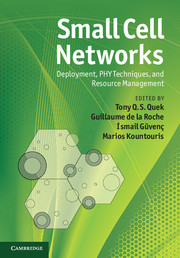Book contents
- Frontmatter
- Contents
- List of contributors
- Foreword by David Chambers
- Acknowledgments
- Acronyms
- 1 Small cell networks overview
- 2 Fundamentals of access control in femtocells
- 3 Coverage analysis using the Poisson point process model
- 4 Interference modeling for cognitive femtocells
- 5 Multiple antenna techniques in small cell networks
- 6 Physical layer techniques for cognitive femtocells
- 7 Femtocell coverage optimization
- 8 Random matrix methods for cooperation in small cell networks
- 9 Mobility in small cell networks
- 10 Cognitive radio resource management in autonomous femtocell networks
- 11 Decentralized reinforcement learning techniques for interference management in heterogeneous networks
- 12 Resource allocation optimization in heterogeneous wireless networks
- 13 New strategies for femto-macro cellular interference control
- 14 Femtocell interference control in standardization
- 15 Spectrum assignment and fairness in femtocell networks
- 16 Self-organization and interference avoidance for LTE femtocells
- Index
- References
1 - Small cell networks overview
Published online by Cambridge University Press: 05 May 2013
- Frontmatter
- Contents
- List of contributors
- Foreword by David Chambers
- Acknowledgments
- Acronyms
- 1 Small cell networks overview
- 2 Fundamentals of access control in femtocells
- 3 Coverage analysis using the Poisson point process model
- 4 Interference modeling for cognitive femtocells
- 5 Multiple antenna techniques in small cell networks
- 6 Physical layer techniques for cognitive femtocells
- 7 Femtocell coverage optimization
- 8 Random matrix methods for cooperation in small cell networks
- 9 Mobility in small cell networks
- 10 Cognitive radio resource management in autonomous femtocell networks
- 11 Decentralized reinforcement learning techniques for interference management in heterogeneous networks
- 12 Resource allocation optimization in heterogeneous wireless networks
- 13 New strategies for femto-macro cellular interference control
- 14 Femtocell interference control in standardization
- 15 Spectrum assignment and fairness in femtocell networks
- 16 Self-organization and interference avoidance for LTE femtocells
- Index
- References
Summary
Driven by a new generation of wireless user equipment and the proliferation of bandwidth-intensive applications, user data traffic and the corresponding network load are increasing in an exponential manner. Most of this new data traffic is being generated indoors, which requires increased link budget and coverage extension to provide satisfactory user experience. As a result, current cellular networks are reaching their breaking point and conventional cellular architectures, which are devised to cater to large coverage areas and optimized for homogeneous traffic, are facing unprecedented challenges to meet these user demands.
In this context, there has been an increasing interest to deploy small cellular access points in residential homes, subways, and offices. These network architectures, which may be either operator deployed and/or consumer installed and are comprised of a mix of low-power cells underlying the macrocell network, are commonly referred to as small cell networks. By deploying additional network nodes within the local area range and bringing the network closer to end users, spatial reuse and coverage can be significantly improved, thus allowing future cellular systems to achieve higher data rates, while retaining the seamless connectivity and mobility of cellular networks.
Inspired by the attractive features and potential advantages of small cell networks, their development and deployment are gaining momentum in the wireless industry and research communities during the last few years. It has also attracted the attention of standardization bodies such as the Third Generation Partnership Project (3GPP) Long Term Evolution (LTE)-Advanced (see Chapter 14) and the IEEE 802.16 Wireless Metropolitan Area Networks.
- Type
- Chapter
- Information
- Small Cell NetworksDeployment, PHY Techniques, and Resource Management, pp. 1 - 12Publisher: Cambridge University PressPrint publication year: 2013



